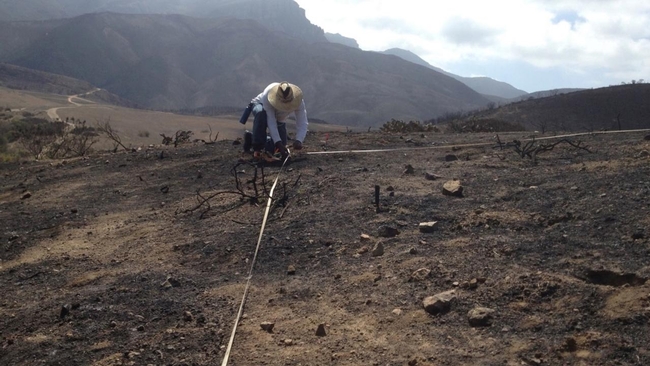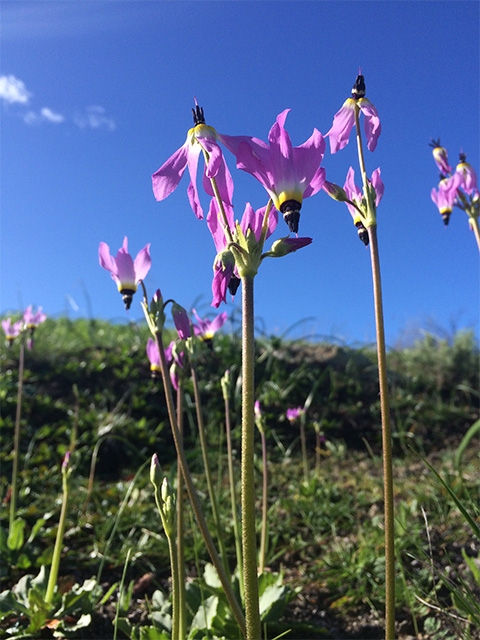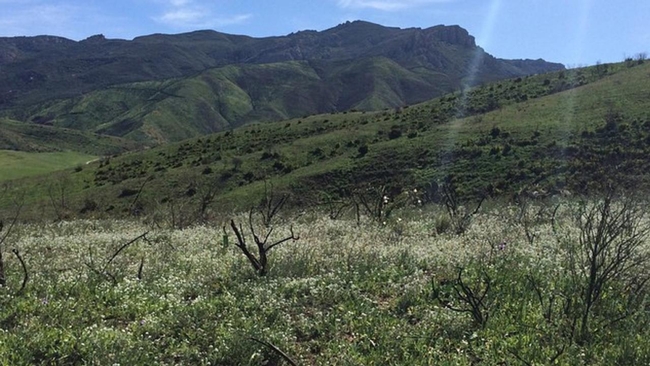Posts Tagged: native plants
Extreme weather accelerates nitrate pollution in groundwater
Extreme weather spurred by climate change, including droughts and heavy rains, may increase the risk of nitrates from fertilizers ending up in groundwater, according to a recent study from researchers at the University of California, Davis. The study found heavy rains after a drought caused nitrates to seep 33 feet under farm fields in as little as 10 days. The study was published in Water Resources Research.
“The conventional wisdom was that it could take several weeks to years for nitrates to move from the crop root zones to reach groundwater,” said corresponding author Isaya Kisekka, a professor in the Departments of Land, Air and Water Resources and Biological and Agricultural Engineering. “We found these extreme events, such as California's atmospheric rivers, are going to move nitrate more quickly.”
In this study, different methods were used to measure how much nitrate, a component of nitrogen fertilizer, was seeping down through the soil in a tomato and cucumber crop near Esparto, California. Scientists conducted their research from 2021 until 2023 when California was experiencing periods of drought followed by atmospheric rivers. They measured nitrate during both the growing seasons and the rainy seasons.
Drought can leave more nitrogen in soil
Previous studies have shown about 40% of nitrogen fertilizer used for vegetables isn't absorbed by the plants but remains in the soil. During droughts, crops don't use nitrogen efficiently, leading to excess nitrogen in the soil. This study found that if a drought is then followed by heavy rainfall, that sudden burst of water causes nitrate to seep in groundwater more quickly. The nitrate concentration in the shallow groundwater exceeded the U.S. Environmental Protection Agency maximum contaminant level of 10 milligrams per liter for drinking water.
“In California, we often say we swing between droughts and floods,” said Kisekka. “These extreme events that come with climate change are going to make the risk of these chemicals ending up in our drinking water much more severe.”
Groundwater is the primary source of drinking water for most of California's Central Valley. In some regions, such as the Tulare Lake Basin, nearly one-third of drinking and irrigation wells exceed the EPA's safe nitrate level. High nitrate levels in drinking water can increase health risks, especially for young children. It may also increase the risk of colorectal cancer.
Need for real-time soil nitrate monitoring
Central Valley farmers are required to report to the Regional Water Board how much nitrogen they applied to their field and how much was removed as part of the crop's yield. The study compared different ways of monitoring when nitrate from fertilizers seep into groundwater. Kisekka said the results highlight the need for affordable, real-time soil nitrate monitoring tools to help farmers manage fertilizer use efficiently.
By using conservation practices that limit leftover nitrates in the crop's root zone after harvest, farmers can help reduce nitrate contamination in groundwater.
This study's data will also help improve a model called SWAT, which is used to track nitrate seepage into groundwater across California's Central Valley. This effort is part of the Central Valley Water Board's program to regulate irrigated farmlands.
Other UC Davis authors include Iael Raij Hoffman, Thomas Harter and Helen Dahlke.
The study was supported by the USDA Natural Resource Conservation Service through its Conservation Effects Assessment Project. The national project is designed to assess the effectiveness of conservation practices across different watersheds. The study also had support from the USDA National Institute of Food and Agriculture.
Using Native Plants for Weed Control
One of the first steps in ecological restoration is often controlling invasive weeds, which can be a major barrier to native plant establishment. But what happens after restoration is complete? At most sites, weed pressure is an ongoing challenge that...
Lawn-pocalypse! Surviving Drought
Ah, summer! The season of sunburns, pool parties, and… lawn droughts. If your once lush, green carpet now looks like a crunchy brown doormat, you're not alone. Let's dive into why your yard is staging a dramatic death scene and what you can do to...

Bermuda grass and weeds overtaking drought stressed turf grass.
Car fumes, weeds pose double-whammy for fire-loving native plants
Wildflower displays threatened
Northwest of Los Angeles, springtime brings native wildflowers to bloom in the Santa Monica Mountains. These beauties provide food for insects, maintain healthy soil and filter water seeping into the ground – in addition to offering breathtaking displays of color.
They're also good at surviving after wildfire, having adapted to it through millennia. But new research shows wildflowers that usually would burst back after a blaze and a good rain are losing out to the long-standing, double threat of city smog and nonnative weeds.
A recent study led by Justin Valliere, assistant professor in the UC Davis Department of Plant Sciences, found that native wildflowers and other plants that typically flourish following a fire were, instead, replaced by invasive plants on land that received the kind of nitrogen contained in vehicle emissions.
“Many native plants in fire-prone areas rely on fire, and some are entirely dependent on it. Some are even most abundant after a fire,” said Valliere, a UC Cooperative Extension specialist in invasive weed and restoration ecology. “But we found that these fire-following species may be especially vulnerable to the combination of nitrogen pollution and invasive plants.”
That's part of the reason why native plants in these mountains have been declining.
Seeds – banked in the soil and waiting to sprout
The problem faced by native plants can be compared to a drawn-down bank account: Funds withdrawn are not being replaced.
It starts with fire, an important ecological process, Valliere said. Flames burn through plants on the surface and return their nutrients to the soil. Seeds sleeping in the ground wait for the next rain to sprout, then use those nutrients to grow.
“Plant diversity is often highest in growing seasons immediately after a site burns,” he said.
But invading plants have many advantages over native ones. They often sprout earlier, grow faster and create more seeds, all while tolerating drought.
“They're like cheaters,” Valliere said. “They don't follow the same rules.”
Nitrogen, too, is an important piece of every plant's nutrition. They all get a fertilizing boost from nitrogen that floats up in vehicle emissions and falls to the ground. But the invaders use nitrogen and other nutrients to grow faster, winning the race for water and sunlight. As a result, fewer native plants reach maturity, producing fewer seeds that keep their populations thriving.
When the bank balance reaches zero
The 2013 Springs Fire gave Valliere a unique opportunity to study the combined impacts of wildfire and extra nitrogen. He and colleagues from UC Riverside and the National Park Service created test plots in the Santa Monica Mountains where the fire had burned. Then, they added nitrogen to the soil to mimic the amount and type that LA's smog would deposit. Over the study's three years, native plants that typically would have flourished after wildfire instead declined even faster in the plots with added nitrogen.
Native seeds sprouted, but didn't flower. Over time, the soil's bank of seeds drew down.
“Each seed has one chance to flower and reproduce,” Valliere said. “If a seed grows and gets outcompeted, that seed has lost its chance to replenish the seed bank.”
Without the chance to replenish their bank account, native plants will die out, and the whole ecosystem will be thrown out of balance.
“There is inherent value in biodiversity,” Valliere said. “These invasive weeds could prevent the re-establishment of native shrubs after fire, sometimes forever altering the plant community.”
The loss of native plants can have cascading effects on the larger environment, he added. Problems can include the loss of native bees that feed on the flowers, and mudslides when rain makes hillsides unstable.
This problem is likely to repeat in similar areas where biodiversity is highest after wildfires – including parts of the Mediterranean basin, southern Africa and Australia. The addition of city smog “could have serious consequences for the biodiversity of fire-prone ecosystems worldwide,” Valliere warned.
Read the paper, “Nitrogen deposition suppresses ephemeral post-fire plant diversity,” by Justin Valliere, Irina Irvine and Edith Allen.
This article was first published on the UC Davis Department of Plant Sciences website.
High Summer in the Native Plant Garden
We Californians understand the concept of summer dormancy: “Those hills aren't brown, they're beautifully golden!” We know that the cycle of seasons plays out a bit more dramatically across our hot, dry countryside than in locales where the...




